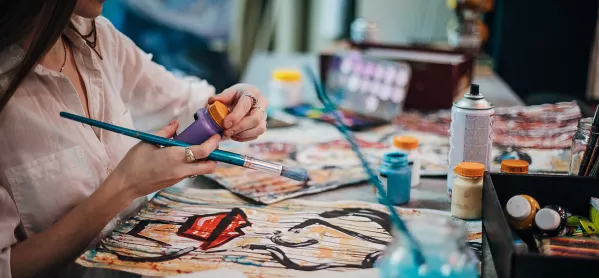Revealed: How Ofsted wants schools to teach art and design

Ofsted has produced its latest subject-focused research review on how schools should approach art and design.
It’s the latest in a series of reviews published by the inspectorate, which is also producing subject reports drawn from findings from its school inspections.
Here are the key findings from the watchdog’s art and design research review.
1. Funding decline may be affecting quality of art education
Ofsted has highlighted a 2018 Fabian Society report, which warned that there has been an overall decrease in arts education, including art and design, music, drama and dance.
The watchdog said there may be a range of reasons for this, including a decline in real-terms funding, meaning pupils have less access to specialist resources and support; schools focusing more on core subjects and less on foundation subjects; and some primary teachers lacking the skills, training and experience to teach a high-quality art curriculum - an issue it says is highlighted in the 2018 report.
2. Schools decide the breadth, depth and sequence of art curriculum
The Ofsted review says that the national curriculum does not set out how to sequence the content that pupils study in art.
It also highlights that some art educators have commented that the national curriculum does not include detail about how schools should build on each stage of development, and that it also doesn’t go into detail about the content that pupils should learn.
Ofsted’s review adds: “This means subject leaders and curriculum planners need to have some sort of idea of what might be ‘cumulatively sufficient’ or ‘collectively enough’ content for the curriculum to be high quality.”
3. Curriculum should not be a ‘superficial tour’
The research review highlights how the National Society for Education in Art and Design recognises 12 different “areas of making”, comprising drawing, painting, printmaking, sculpture, ceramics, creative craft, collage, textiles, photography, installation and site-specific work, digital and new media, and design and graphic design.
It notes that the national curriculum specifies three of these (drawing, painting and sculpture) but also suggests that schools will include areas of making beyond these three.
- Ofsted: Inspection findings on science teaching
- Deep dives: Watchdog doesn’t know how many deep dives it carries out into each subject
- Controversy: Amanda Spielman defends Ofsted subject research
Ofsted goes on to say that subject leaders and curriculum designers should have “a sound rationale” for how their selection of areas of making included in the curriculum are cumulatively sufficient.
It also says schools will need to have a rationale for which areas of making they teach and revisit over time, and which areas they will not teach. “This prevents the art curriculum from collapsing into a superficial tour”, the watchdog adds.
4. Importance of KS3
The inspectorate has said that key stage 3 may be the last opportunity for a pupil to engage “critically and creatively” with art during their education.
The review adds: “It is the time when pupils build on the knowledge they learned at primary school, and when teachers address gaps in pupils’ subject knowledge.”
Ofsted’s review says that the KS3 curriculum needs to give pupils the breadth and depth of knowledge necessary for them to be successful at KS4 and beyond.
It adds: “An art curriculum that significantly limits the amount of time given to the subject is unlikely to benefit pupils.”
5. Ofsted identifies art knowledge schools should develop
Ofsted says schools that offer high-quality art and design education may ensure that curriculum content is chosen specifically to enable pupils to build “practical, theoretical and disciplinary subject-specific knowledge”.
It says practical knowledge is about pupils developing technical skills; theoretical knowledge gives pupils the cultural and contextual content about artists and artwork; and disciplinary knowledge is what pupils learn about how art is studied, discussed and judged.
6. Leaders need to support teachers’ development
The review notes that many art and design teachers may be practising artists, which can enrich and support their work.
It adds: “However, school leaders need to ensure that they give teachers and subject leaders enough time and support to develop their subject content knowledge and pedagogical content knowledge. If teachers lack this knowledge, they will struggle to provide a rich, subject-specific curriculum that develops pupils’ knowledge and capacities.”
7. Risk of ‘lumping’ art and design with other subjects
The report highlights how school leaders in primary and secondary schools have to balance many subjects in the timetabled curriculum.
It says they may choose to teach art discretely or integrate it with other subject areas.
The inspectorate’s research review adds that schools must plan adequate time for art, craft and design. Ofsted said that it is often linked to other subjects, such as maths, religious education and history.
It adds: “In secondary schools, art, craft and design might be blended into work around wellbeing in personal, social and health education.”
Ofsted’s review says: “A well-sequenced curriculum can help pupils make links and connections between different subject areas. But there are risks to the quality of art, craft and design when they are taught in carousel or lumped together with all content in the visual and performance curriculum.”
You need a Tes subscription to read this article
Subscribe now to read this article and get other subscriber-only content:
- Unlimited access to all Tes magazine content
- Exclusive subscriber-only stories
- Award-winning email newsletters
Already a subscriber? Log in
You need a subscription to read this article
Subscribe now to read this article and get other subscriber-only content, including:
- Unlimited access to all Tes magazine content
- Exclusive subscriber-only stories
- Award-winning email newsletters
topics in this article



